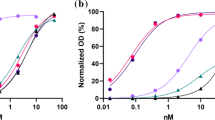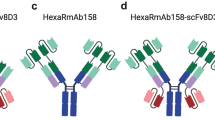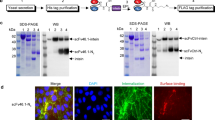Abstract
Delivery of therapeutic proteins into tissues and across the blood–brain barrier (BBB) is limited by the size and biochemical properties of the proteins. Efficient delivery across BBB is generally restricted to small, highly lipophilic molecules. However, in the last decades, several peptides that can pass cell membranes have been identified. It has been shown that these peptides are also capable of delivering large hydrophilic cargoes into cells and are therefore a powerful biological tool for transporting drugs across cell membranes and even into the brain. We designed and prepared a single-chain antibody fragment (scFvs), specific for the pathological form of the prion protein (PrPSc), where a cell-penetrating peptide (CPP) was used as a linker between the two variable domains of the scFv. The intravenously administered recombinant scFv-CPP was successfully targeted to and delivered into mouse brain cells. Our single-chain antibody fragments are of special interest in view of possible therapeutic reagents design not only for prion diseases but also for other neurodegenerative diseases.




Similar content being viewed by others
Abbreviations
- ABTS:
-
2,2′-Azino-bis(3-ethylbenzthiazoline-6-sulphonic acid)
- CNS:
-
Central nervous system
- CPP:
-
Cell-penetrating peptides
- DAPI:
-
4′,6-Diamidino-2-phenylindole
- Fv:
-
Antibody variable domains (Vl + Vh)
- HRP:
-
Horseradish peroxidase
- IMAC:
-
Immobilized metal ion affinity chromatography
- IPTG:
-
Isopropyl β-d-1-thiogalactopyranoside
- LLH:
-
scFv in Vl-linker-Vh chain arrangement
- PBS:
-
Phosphate-buffered saline
- PrP:
-
Prion protein
- PrPC :
-
Cellular form of the PrP
- PrPSc :
-
Pathogenic form of the PrP
- scFv:
-
Antibody single-chain fragment
- TBS:
-
Tris-buffered saline
- TMB:
-
3,3′,5,5′-Tetramethylbenzidine
- Vh:
-
Variable domain of the heavy-chain of an antibody
- Vl:
-
Variable domain of the light chain of an antibody
References
Bird, R. E., Hardman, K. D., Jacobson, J. W., Johnson, S., Kaufman, B. M., Lee, S. M., et al. (1988). Single-chain antigen-binding proteins. Science, 242, 423–426.
Huston, J. S., Levinson, D., Mudgett-Hunter, M., Tai, M. S., Novotný, J., Margolies, M. N., et al. (1988). Protein engineering of antibody binding sites: recovery of specific activity in an anti-digoxin single-chain Fv analogue produced in Escherichia coli. Proceedings of the National Academy of Sciences of the United States of America, 85, 5879–5883.
Robert, R., & Wark, K. L. (2012). Engineered antibody approaches for Alzheimer’s disease immunotherapy. Archives of Biochemistry and Biophysics, 526, 132–138.
Pardridge, W. M. (2007). Drug targeting to the brain. Pharmaceutical Research, 24, 1733–1744.
Begley, D. J. (2004). Delivery of therapeutic agents to the central nervous system: the problems and the possibilities. Pharmacology & Therapeutics, 104, 29–45.
Hanson, L. R., & Frey, W. H. (2008). Intranasal delivery bypasses the blood–brain barrier to target therapeutic agents to the central nervous system and treat neurodegenerative disease. BMC Neuroscience, 9(Suppl 3), S5.
Lindgren, M., Hällbrink, M., Prochiantz, A., & Langel, U. (2000). Cell-penetrating peptides. Trends in Pharmacological Sciences, 21, 99–103.
Frankel, A. D., & Pabo, C. O. (1988). Cellular uptake of the tat protein from human immunodeficiency virus. Cell, 55, 1189–1193.
Green, M., & Loewenstein, P. M. (1988). Autonomous functional domains of chemically synthesized human immunodeficiency virus tat trans-activator protein. Cell, 55, 1179–1188.
Joliot, A. H., Triller, A., Volovitch, M., Pernelle, C., & Prochiantz, A. (1991). alpha-2,8-Polysialic acid is the neuronal surface receptor of antennapedia homeobox peptide. New Biologist, 3, 1121–1134.
Schwarze, S. R., & Dowdy, S. F. (2000). In vivo protein transduction: intracellular delivery of biologically active proteins, compounds and DNA. Trends in Pharmacological Sciences, 21, 45–48.
Dietz, G. P. H., & Bähr, M. (2004). Delivery of bioactive molecules into the cell: the Trojan horse approach. Molecular and Cellular Neurosciences, 27, 85–131.
Dupont, E., Prochiantz, A., & Joliot, A. (2011). Penetratin story: an overview. Methods in Molecular Biology, 683, 21–29.
Gratton, J.-P., Yu, J., Griffith, J. W., Babbitt, R. W., Scotland, R. S., Hickey, R., et al. (2003). Cell-permeable peptides improve cellular uptake and therapeutic gene delivery of replication-deficient viruses in cells and in vivo. Nature Medicine, 9, 357–362.
Jain, M., Chauhan, S. C., Singh, A. P., Venkatraman, G., Colcher, D., & Batra, S. K. (2005). Penetratin improves tumor retention of single-chain antibodies: a novel step toward optimization of radioimmunotherapy of solid tumors. Cancer Research, 65, 7840–7846.
Schutze-Redelmeier, M. P., Gournier, H., Garcia-Pons, F., Moussa, M., Joliot, A. H., Volovitch, M., et al. (1996). Introduction of exogenous antigens into the MHC class I processing and presentation pathway by Drosophila antennapedia homeodomain primes cytotoxic T cells in vivo. Journal of Immunology, 157, 650–655.
Théodore, L., Derossi, D., Chassaing, G., Llirbat, B., Kubes, M., Jordan, P., et al. (1995). Intraneuronal delivery of protein kinase C pseudosubstrate leads to growth cone collapse. Journal of Neuroscience, 15, 7158–7167.
Derossi, D., Joliot, A. H., Chassaing, G., & Prochiantz, A. (1994). The third helix of the Antennapedia homeodomain translocates through biological membranes. Journal of Biological Chemistry, 269, 10444–10450.
Prusiner, S. B. (1998). Prions. Proceedings of the National Academy of Sciences of the United States of America, 95, 13363–13383.
Müller-Schiffmann, A., & Korth, C. (2008). Vaccine approaches to prevent and treat prion infection: progress and challenges. BioDrugs: Clinical Immunotherapeutics, Biopharmaceuticals and Gene Therapy, 22, 45–52.
Solforosi, L., Criado, J. R., McGavern, D. B., Wirz, S., Sánchez-Alavez, M., Sugama, S., et al. (2004). Cross-linking cellular prion protein triggers neuronal apoptosis in vivo. Science, 303, 1514–1516.
Alexandrenne, C., Hanoux, V., Dkhissi, F., Boquet, D., Couraud, J.-Y., & Wijkhuisen, A. (2009). Curative properties of antibodies against prion protein: a comparative in vitro study of monovalent fragments and divalent antibodies. Journal of Neuroimmunology, 209, 50–56.
Čurin Šerbec, V., Bresjanac, M., Popović, M., Pretnar Hartman, K., Galvani, V., Rupreht, R., et al. (2004). Monoclonal antibody against a peptide of human prion protein discriminates between Creutzfeldt-Jacob’s disease-affected and normal brain tissue. Journal of Biological Chemistry, 279, 3694–3698.
Vranac, T., Hartman, K. P., Popović, M., Venturini, A., Žerovnik, E., & Čurin Šerbec, V. (2006). A single prion protein peptide can elicit a panel of isoform specific monoclonal antibodies. Peptides, 27, 2695–2705.
Koren, S., Kosmač, M., Colja Venturini, A., Montanič, S., & Čurin Šerbec, V. (2008). Antibody variable-region sequencing as a method for hybridoma cell-line authentication. Applied Microbiology and Biotechnology, 78, 1071–1078.
Kosmač, M., Koren, S., Giachin, G., Stoilova, T., Gennaro, R., Legname, G., et al. (2011). Epitope mapping of a PrP(Sc)-specific monoclonal antibody: identification of a novel C-terminally truncated prion fragment. Molecular Immunology, 48, 746–750.
Škrlj, N., Erčulj, N., & Dolinar, M. (2009). A versatile bacterial expression vector based on the synthetic biology plasmid pSB1. Protein Expression and Purification, 64, 198–204.
Škrlj, N., Čurin Šerbec, V., & Dolinar, M. (2010). Single-chain Fv antibody fragments retain binding properties of the monoclonal antibody raised against peptide P1 of the human prion protein. Applied Biochemistry and Biotechnology, 160, 1808–1821.
Škrlj, N., Vranac, T., Popović, M., Čurin Šerbec, V., & Dolinar, M. (2011). Specific binding of the pathogenic prion isoform: development and characterization of a humanized single-chain variable antibody fragment. PloS One, 6, e15783.
Raag, R., & Whitlow, M. (1995). Single-chain Fvs. FASEB Journal, 9, 73–80.
Peter, J.-C., Lecourt, A.-C., Weckering, M., Zipfel, G., Niehoff, M. L., Banks, W. A., et al. (2010). A pharmacologically active monoclonal antibody against the human melanocortin-4 receptor: effectiveness after peripheral and central administration. Journal of Pharmacology and Experimental Therapeutics, 333, 478–490.
Banks, W. A. (2008). Delivery of peptides to the brain: emphasis on therapeutic development. Biopolymers, 90, 589–594.
Bertrand, J. R., Malvy, C., Auguste, T., Toth, G. K., Kiss-Ivankovits, O., Illyes, E., et al. (2009). Synthesis and studies on cell-penetrating peptides. Bioconjugate Chemistry, 20, 1307–1314.
Mäe, M., & Langel, U. (2006). Cell-penetrating peptides as vectors for peptide, protein and oligonucleotide delivery. Current Opinion in Pharmacology, 6, 509–514.
Pouniotis, D. S., Esparon, S., Apostolopoulos, V., & Pietersz, G. A. (2011). Whole protein and defined CD8(+) and CD4(+) peptides linked to penetratin targets both MHC class I and II antigen presentation pathways. Immunology and Cell Biology, 89, 904–913.
Avignolo, C., Bagnasco, L., Biasotti, B., Melchiori, A., Tomati, V., Bauer, I., et al. (2008). Internalization via Antennapedia protein transduction domain of an scFv antibody toward c-Myc protein. FASEB Journal, 22, 1237–1245.
Epenetos, A., & Kousparou, C. (2010). Therapeutic Antennapedia-antibody molecules and methods of use thereof. US Patent Application 20100266592. London: Trojan Technologies.
Huang, Y., Rao, Y., Feng, C., Li, Y., Wu, X., Su, Z., et al. (2008). High-level expression and purification of Tat-haFGF19-154. Applied Microbiology and Biotechnology, 77, 1015–1022.
Nitin, N., LaConte, L., Rhee, W. J., & Bao, G. (2009). Tat peptide is capable of importing large nanoparticles across nuclear membrane in digitonin permeabilized cells. Annals of Biomedical Engineering, 37, 2018–2027.
Marfori, M., Mynott, A., Ellis, J. J., Mehdi, A. M., Saunders, N. F. W., Curmi, P. M., et al. (2011). Molecular basis for specificity of nuclear import and prediction of nuclear localization. Biochimica et Biophysica Acta, 1813, 1562–1577.
Holliger, P., & Hudson, P. J. (2005). Engineered antibody fragments and the rise of single domains. Nature Biotechnology, 23, 1126–1136.
Verma, R., Boleti, E., & George, A. J. (1998). Antibody engineering: comparison of bacterial, yeast, insect and mammalian expression systems. Journal of Immunological Methods, 216, 165–181.
Korth, C., Stierli, B., Streit, P., Moser, M., Schaller, O., Fischer, R., et al. (1997). Prion (PrPSc)-specific epitope defined by a monoclonal antibody. Nature, 390, 74–77.
Féraudet, C., Morel, N., Simon, S., Volland, H., Frobert, Y., Créminon, C., et al. (2005). Screening of 145 anti-PrP monoclonal antibodies for their capacity to inhibit PrPSc replication in infected cells. Journal of Biological Chemistry, 280, 11247–11258.
Paramithiotis, E., Pinard, M., Lawton, T., LaBoissiere, S., Leathers, V. L., Zou, W.-Q., et al. (2003). A prion protein epitope selective for the pathologically misfolded conformation. Nature Medicine, 9, 893–899.
Jones, M., Wight, D., McLoughlin, V., Norrby, K., Ironside, J. W., Connolly, J. G., et al. (2009). An antibody to the aggregated synthetic prion protein peptide (PrP106-126) selectively recognizes disease-associated prion protein (PrP) from human brain specimens. Brain Pathology, 19, 293–302.
Horiuchi, M., Karino, A., Furuoka, H., Ishiguro, N., Kimura, K., & Shinagawa, M. (2009). Generation of monoclonal antibody that distinguishes PrPSc from PrPC and neutralizes prion infectivity. Virology, 394, 200–207.
Ludewigs, H., Zuber, C., Vana, K., Nikles, D., Zerr, I., & Weiss, S. (2007). Therapeutic approaches for prion disorders. Expert Review of Anti-infective Therapy, 5, 613–630.
Ahmad, Z.A., Yeap, S.K., Ali, A.M., Ho, W.Y., Alitheen, N.B.M., Hamid, M. (2012). scFv antibody: principles and clinical application. Clinical & Developmental Immunology, 2012, 980250.
Acknowledgments
This work was supported by the Slovenian Research Agency Ph.D. grant for N. Škrlj.
Author information
Authors and Affiliations
Corresponding author
Rights and permissions
About this article
Cite this article
Škrlj, N., Drevenšek, G., Hudoklin, S. et al. Recombinant Single-Chain Antibody with the Trojan Peptide Penetratin Positioned in the Linker Region Enables Cargo Transfer Across the Blood–Brain Barrier. Appl Biochem Biotechnol 169, 159–169 (2013). https://doi.org/10.1007/s12010-012-9962-7
Received:
Accepted:
Published:
Issue Date:
DOI: https://doi.org/10.1007/s12010-012-9962-7




